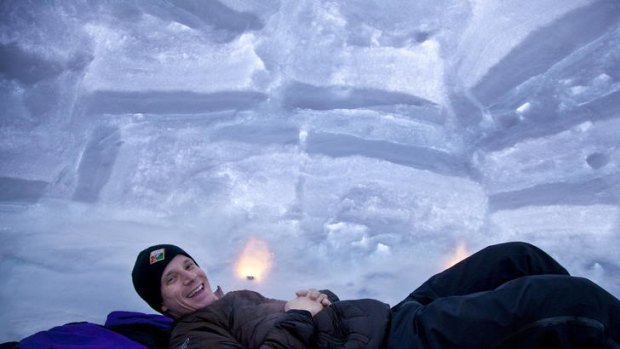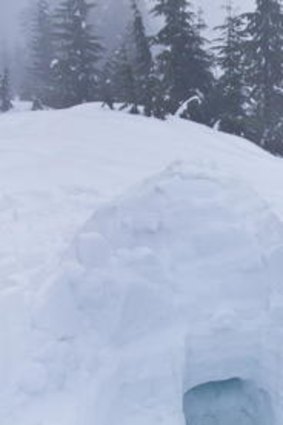
Chilling out ... Steve Santelli kicks back on a sheepskin rug inside the finished shelter.Credit: Remy Scalza
There's just something about an igloo, writes Remy Scalza, who tries to build one.
CHILLED from a day in the snow, worn out from hours of shovelling and stacking snow blocks, we worm our way into the tunnel of the igloo one after another. The wind's howl mutes to a low hum. The day's grey light goes black. I follow the pair of boots in front, crawling in towards the glimmer of light ahead.
The boots belong to Michael Harding, igloo evangelist. An outdoor guide with baby-blue eyes and snow-white hair, Harding has raised untold hundreds of igloos in this corner of western Canada. "They're warmer than tents," he'd explained earlier this morning as we climbed into the back country of the mountains outside Vancouver in his late-model Nissan Pathfinder. "They're soundproof. They're practically cozy."

Cheers all round as construction is complete.Credit: Remy Scalza
I've joined him and another guide for a one-day crash course in igloo basics, dragging along a friend from Vancouver for this most Canadian rite of passage. Not that I'm planning an assault on K2 any time soon. But even for armchair adventurers, there's just something about an igloo.
Our proving ground today is a plateau high on Cypress Mountain, whose 1440-metre peaks rise just beyond Vancouver's city limits. The host of the 2010 Olympic ski events, Cypress is stubbornly wild. More than 10 metres of snow fell here last winter and the endless, craggy back country provides a popular training ground for hardcore hikers gearing up for expeditions to Mount Baker in Washington, Mount McKinley in Alaska and other high peaks of the North American west. Never mind the tots in ski boots in the parking lot and the legions of Lululemon-wearing hikers: Cypress still feels extreme.
Harding's eyes are shining on this rare sunny morning as our small group sets off down the trail. A young-looking 62, with an accent that betrays his English roots, Harding got hooked on Vancouver's epic scenery while backpacking here in his 20s.
Our group today, in snowshoes and sporting heavy packs, might pass as intrepid outdoors types but this is just a trial run, practice should we ever venture into the mountains for a real expedition.
Fraught with hazards fair-weather campers rarely face, winter camping in Vancouver is serious business. In fact, I initially had ambitions of an overnight trip. But after watching the weather forecast with trepidation all week, wondering if my Walmart ski parka and borrowed sleeping bag would be up to the challenge, I got a reprieve. With a storm blowing in, the grizzled trip leader, with no time for newbies, politely recommended I invest in some proper equipment and remedial training first. Igloo 101 seemed a good place to start.
Climbing up Cypress under blue skies, we pass a signposted trail warning of avalanche country ahead - a reminder of the threats that accompany even day trips into the back country.
After huffing our way up a long, snowy ridge, we're greeted with an only-in-Vancouver view: hundreds of metres below, half-hidden by shifting clouds, a cityscape of glass towers cascades towards the grey-green waters of the Pacific. Plumes of vapour billow into the air as we catch our breath.
Abandoning the trail, the group crunches along to a nearby clearing flanked by pines buried to mid-trunk in snow.
Harding's second in command, 31-year-old Steve Santelli, fresh off a week-long expedition to the 5500-metre mark of Denali in Alaska, unloads a threatening arsenal of steel shovels and snow saws with serrated teeth.
"There's something about being in the middle of nowhere, in the freezing cold, miles from help," he says, meditating on joys of winter camping to which I can't really relate. With a telescoping metal probe, Harding tests the snow, prodding for rocks, trees and buried hazards with the delicate touch of a surgeon. The pole sinks down - one metre, two metres, three metres - before sounding bottom. When a cold wind picks up, he spreads the gospel: "Even if it's howling outside it can be completely silent in the igloo. You'd never believe it."
Harding, in fact, has good reason to be enthusiastic. Traditional winter dwellings of Canada's Inuit, igloos are engineering marvels. Their precision-carved blocks curve inward and upward in an elegant, self-reinforcing spiral.
The dome itself is a miracle of resiliency, strong enough to support the weight of a grown man after freezing over. And they're marvellously efficient at trapping body heat. Even in polar conditions, the interior stays a relatively balmy zero degrees. Not to mention that all the building materials are right at hand.
Construction starts with a dance. Still strapped into snowshoes, we trace a circle two metres in diameter in the snow and begin stomping. The idea is to compress layers of powder, slush and ice into a uniform pack, from which we'll quarry blocks for the igloo.
We stomp on for a good 10 minutes, circling in a snowshoe-clad jig while my Vancouver friend Peter Walter, also new to the world of igloos, peppers the guides with questions. "So, how about campfires inside the igloo?" he asks. For many good and suddenly obvious reasons - melting snow, smoke, suffocation - they strongly counsel against it.
With the packing done, Harding shovels out a small, knee-deep cubicle in the snow and jumps in. Flashing his saw, he carves out a block with a series of practised strokes. Efforts by the rest of the team leave a little more to be desired. Blocks crumble frustratingly and shear off along fault lines. But by the end of an hour, sweaty and sucking air, we've got our material: 50 or so glittering snow bricks. It's time to build.
With impressive speed, blue skies dim down to a threatening grey. A thick mist creeps in. A light drizzle starts, clinging to our clothes and exposed skin, wicking away warmth. And the building has only just started.
The first blocks are critical. To get the classic dome shape, they have to lean inward like teetering towers of Pisa. I plant one down with a satisfying thud as Harding spreads a mortar of loose snow with a gloved hand. Other blocks follow, custom cut with the snow saw for a smooth fit and nestled edge to edge.
As we build, bundled-up couples in snowshoes and families out for a winter hike swarm the growing dome like paparazzi. Children peer inside, desperately wanting to help. A parade of dogs in sweaters sniffs the perimeter and threatens to yellow our masterpiece. "There's something magical about building a little house in the snow," Harding says. "People love it. It's so simple and so beautiful."
By the third damp hour of construction, however, spirits are low. My hand-me-down gloves and ski pants have soaked through and my hearty breakfast of muesli and mixed fruit is hardly holding me over. Santelli, meanwhile, is regaling the group with a real adventure tale about the time he got crippling altitude sickness only metres from the 3286-metre summit of Mount Baker. Nose running shamelessly, I man up and labour on.
A flask of hot tea is passed around and now, with merciful speed, things come together. Walls rise, the dome arches higher and, finally, there's just a single skylight in the roof left to be capped.
Buoyant now, Harding eyeballs a block, shaves it down and extends it to waiting hands poking through the hole.
The result is impressive: a tidy dome of uniform blocks rising from a field of white. But it's what's inside that counts. For Harding, a day of braggadocio - of igloo warmth, comfort, superior construction - all comes down to this. I've got my doubts. Wriggling down the entrance tunnel in my wet gear, I'm expecting something like a dark, cold tomb.
Hardly. The interior is radiant, flooded with light tinged blue by the dome of snow above. It's roomy enough to turn around and nearly stand up in, nothing like the claustrophobic confines of a typical tent. The sounds of the wind blowing outside are indeed muted to a whisper. Overhead, layers of snow and ice crystals meet at intricate angles, like some baroque ceiling painting. I'm an instant igloo convert.
After a precious few minutes of sanctuary, I slip back through the tunnel and out into the wet Vancouver afternoon. The winter light is fading. It's time to push down the trail.
Sadly, because the igloo might get snowed over and pose a hidden hazard for skiers, we have to demolish our creation. A few kicks to the white walls send the new dome tumbling down, a desecration to be sure. But, Harding promises, others will rise.
Trip notes
Getting there
Delta Air Lines flies from Sydney to Vancouver, with a stopover in Los Angeles, starting at about $1600 return.
Staying there
The Fairmont Waterfront hotel (900 Canada Place Way, Vancouver; +1 866 540 4509; fairmont.com/waterfront) in downtown Vancouver has rooms from $C230 ($220).
In the mountains, the Nita Lake Lodge (2131 Lake Placid Road, Whistler; +1 888 755 6482; nitalakelodge.com) is a chalet-style boutique hotel. Suites start at $C140.
See + do
Michael Harding's Westcoast Adventures (1150 Burnaby Street, Vancouver; +1 604 662 7209; westcoast-adventures.com) offers day-long igloo-building experiences for $C150 a person (minimum four people). It also hosts multi-night expeditions for the "pampered" igloo camper, including chef- made meals from your snow kitchen, dog-sledding and igloos decked out with sheepskin rugs and tea candles ($C1092-$C2625 a person, minimum four people).
For a more rigorous introduction, Canada West Mountain School (47 West Broadway, Vancouver; +1 888 892 2266; themountainschool.com) leads the popular overnight snow-camping and igloo-building workshop ($C255 a person).
Campers ski or snowshoe into the Vancouver mountains for lessons in igloo and snow-cave construction, as well as training in essential winter survival skills and avalanche safety.
Sign up for the Traveller Deals newsletter
Get exclusive travel deals delivered straight to your inbox. Sign up now.